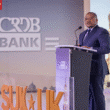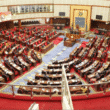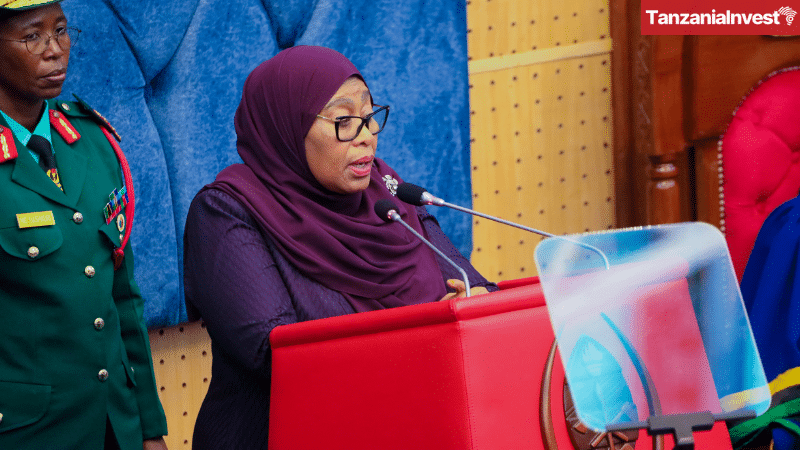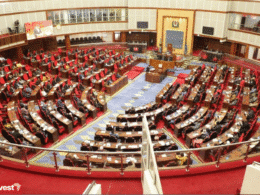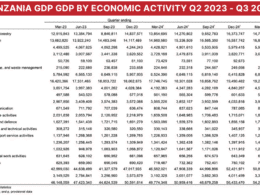On November 14, 2025, President Samia Suluhu Hassan officially opened the 13th Parliament of the United Republic of Tanzania with a comprehensive speech outlining the government’s strategic priorities for the next five years.
Speaking in the capital, Dodoma, President Hassan emphasized a shift towards implementing the National Development Vision 2025-2050, with a sharp focus on building an inclusive, self-reliant economy.
Addressing the newly elected Members of Parliament following the October 29 general election, the President laid out ambitious targets to accelerate economic growth from the current 5.6% to over 7% by 2030.
Her administration’s strategy hinges on leveraging Tanzania’s geographical advantage, industrializing the economy, and maximizing value addition in key productive sectors.
Table of Contents
Economic Outlook and Business Environment
President Hassan reiterated the government’s commitment to the “macro-micro” economic growth model, ensuring national economic gains translate to individual livelihoods.
- GDP Growth: The government targets an increase in economic growth to over 7% by 2030, up from the current 5.6%.
- Business Reforms: The administration pledges to finalize the Blueprint for Regulatory Reforms to Improve the Business Environment (MKUMBI II)and implement tax reform recommendations to ease the cost of doing business.
- Digital Procurement: To support local enterprise, specific opportunities will be opened for youth and small business owners to register on the Tanzania National e-Procurement System (TANSIS).
Infrastructure: The Backbone of Trade
Acknowledging Tanzania’s status as a gateway to Eastern and Southern Africa, the President detailed a “Multimodal Transport System” strategy to integrate ports, railways, and airports.
Railway Expansion (SGR)
The government confirmed the continuation of the Standard Gauge Railway (SGR) construction along the central corridor, specifically the Makutupora-Tabora, Tabora-Isaka, Isaka-Mwanza, and Tabora-Kigoma sections, as well as the Uvinza-Musongati line linking to Burundi. New strategic lines were also announced:
- Tanga to Musoma SGR line.
- Mtwara to Mbamba Bay (Ruvuma) line, connecting to the iron and coal rich areas of Mchuchuma and Liganga.
- Urban Rail: Modern commuter trains are planned for Dar es Salaam and Dodoma to decongest these rapidly growing cities.
Ports and Logistics
- Dar es Salaam Port: Plans are underway to add 10 new berths to the existing 12, significantly expanding capacity.
- New Ports: A new port is slated for Bagamoyo, which will be linked to the Kwala Dry Port.
- Regional Connectivity: The port of Mtwara will be expanded and linked by rail to Mbamba Bay on Lake Nyasa to serve the southern corridor.
Energy Sector
President Hassan emphasized that reliable energy is non-negotiable for industrialization.
- Generation Capacity: The target is to double power generation from the current 4,000 Megawatts (MW) to 8,000 MW by 2030.
- LNG Project: The President addressed the $42 billion Liquefied Natural Gas (LNG) project, assuring investors that negotiations are in advanced stages. The delay has been attributed to the government’s insistence on securing broad national interests and direct benefits for Tanzanians.
- Mix: The energy mix will diversify to include hydro, solar, gas, geothermal, wind, and potentially nuclear power.
Industrialization and Manufacturing
The government aims to raise the manufacturing sector’s growth rate from 4.8% to 9% per year by 2030.
- Industrial Parks: Following the development of Kwala and Buzwagi parks, a new modern industrial cluster is planned for Bagamoyo.
- District-Level Strategy: The administration plans to establish industrial parks in every district to add value to local agricultural and mineral produce.
- Reviving Idle Factories: Privatized industries that have been abandoned will be reclaimed and handed over to cooperative unions capable of operating them.
Mining: Sovereign Wealth Fund & Local Refining
The mining sector’s contribution to GDP has risen to 10.1% in 2024. The focus now shifts to critical minerals and retaining value within the country.
- Local Refining: A multipurpose refinery is planned for completion by 2030 to end the export of raw mineral concentrates.
- Sovereign Wealth Fund: A “Minerals Sovereign Wealth Fund” will be established to invest earnings from finite mineral resources for future generations.
- Trading Hub: The goal is to position Tanzania as the central hub for mineral trading in East and Central Africa by 2030, anchored by the Tanzanite Exchange Centre in Mirerani.
Agriculture and Blue Economy
Under the mantra “Agriculture is Business,” the sector is targeted to grow from 4% to 10% by 2030.
- Irrigation: Irrigated land will increase from 3.4 million acres to 5 million acres, with new schemes in the Rufiji Basin.
- Blue Economy: Construction of the Kilwa Fishing Port is ongoing, creating an estimated 30,000 jobs. A new fishing port and processing cluster are also planned for Bagamoyo.
Tourism
The government has set a target of attracting 8 million tourists by 2030. Strategies include diversifying products to prolong visitor stays and upgrading hospitality training institutions.
Political Stability and Governance
Addressing the recent general election held on October 29, 2025, President Hassan acknowledged the occurrence of post-election unrest.
She announced the formation of an Enquiry Commission to investigate the events and a subsequent Commission for Reconciliation and Mediation to foster national unity.
The President affirmed that the process for rewriting the Constitution would begin within the first 100 days of this second term, signaling a commitment to strengthening democratic institutions and long-term stability.

